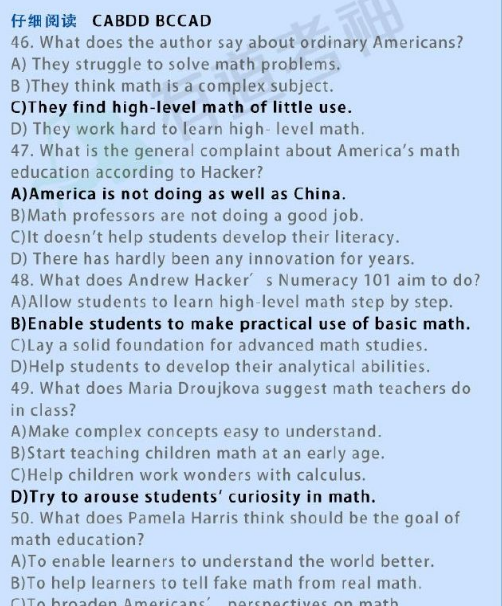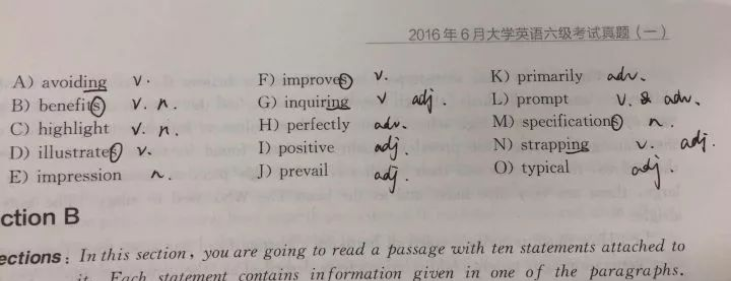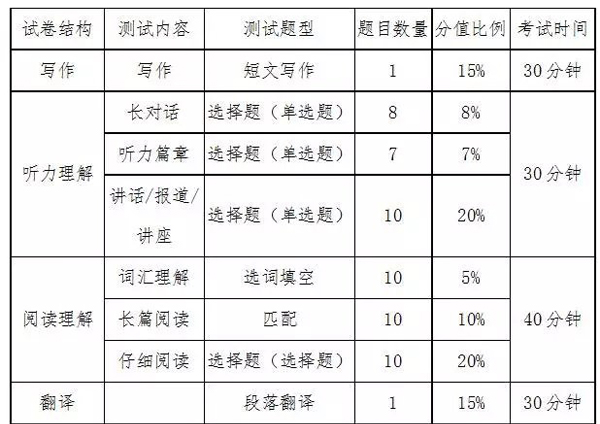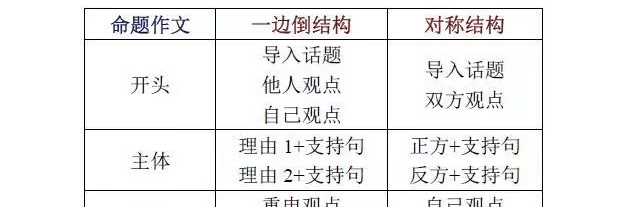恩波名师谢钟明点评四六级新题型样卷
|
试卷构成 样卷分析 令人耳目一新的是题序有所调整,原来的写作是在试卷二上,是第五部分,而现在则调整到第一部分,而阅读的测试则一分为二,分别为第二部分和第四部分,写作和快速阅读合二为一,在试卷一上,用时45分钟,分值比例为25%。 2) 题型的设置 第二部分快速阅读题量为10题,1到7题为是非判断题,如果与文章内容相符,就选“Y”,不相符则为N,若所含信息文章中没有提及,则为NG(Not Given没有给出),8到10题为完成句子,实际上就是老题中的简短回答题(SAQ)的翻版。 第三部分听力理解的调整动作很大,题量大增,有46道之多,分成ABC三个小部分(Section 3),用时35分钟,Section A对话部分,8个短对话,2段长对话,题量有7至8个,共15题;Section B仍是短文理解,3篇文章,10个问题,每篇短文后3至4个问题,这两部分都是多项选择题;Section C是复合式听写,原来老题型中是三篇文章的替换,现在变成必考内容,且听写的单词由原来的7个变成8个,单句不变,仍为3句(并列复合句和主从复合句),用时25分钟。 第四部分Reading In Depth也一分为二,Section A为造词填空要求考生从一个词量为15个单词的词库中选出10个分别填入(根据文章内容)10个空格中;而Section B为两篇文章,每篇文章原来5道问题,袭用传统题型。 第五部分为完型填空,仍然袭用传统形式,一篇文章二十个空格,每个空格提供A、B、C、D四个选项,15分钟。 第六部分为翻译,Translation,用时5分钟,命题形式是给出未完成的句子,缺失部分用中文标示出,要求考生将中文译成准确、规范的英文。用时5分钟。 3) 新增题型的分析 快速阅读:测试多项快速阅读技能,主要是Skimming 和Scanning。样题给出的文章长度为1000个单词左右(教学要求中规定的标准是每分钟100个单词左右,也就是10分钟完成), 后设10道题,前7个为正误判断,后来3个为句子完成,相等于前面的SAQ。这是一篇标题文章,大标题是Landfills,主要内容讲述的是垃圾填埋场。引入性文字之后,文章的主体部分分设七个小标题,涉及到垃圾量, 处理方式,填埋场的定义,规划,修建,运作等方面,从所出的10道题来看,只有第1题涉及文章的大意,其余9题全是文章中的重要细节,因此,寻读的能力就显得尤为重要。 翻译:与往年考过的翻译不同,新题型中的汉译英的句子不是从阅读文章中抽取,而是测的是考生对句子短语或常用表达层次上的中译英能力,考生如果词汇量够用,且具备扎实的语法知识(主要是句法),还是可以应付如裕。 总体评价:
附:新题型样题 大学英语四级考试试点考试样卷 Part II Reading Comprehension (Skimming and Scanning) (15 minutes) Directions: In this part, you will have 15 minutes to go over the passage quickly and answer the questions on Answer Sheet 1. For questions 1-7, mark Y (for YES) if the statement agrees with the information given in the passage; N (for NO) if the statement contradicts the information given in the passage; NG (for NOT GIVEN) if the information is not given in the passage. For questions 8-10, complete the sentences with the information given in the passage. Landfills You have just finished your meal at a fast food restaurant and you throw your uneaten food, food wrappers, drink cups, utensils and napkins into the trash can. You don't think about that waste again. On trash pickup day in your neighborhood, you push your can out to the curb, and workers dump the contents into a big truck and haul it away. You don't have to think about that waste again, either. But maybe you have wondered, as you watch the trash truck pull away, just where that garbage ends up. Americans generate trash at an astonishing rate of four pounds per day per person, which translates to 600,000 tons per day or 210 million tons per year! This is almost twice as much trash per person as most other major countries. What happens to this trash? Some gets recycled (回收利用) or recovered and some is burned, but the majority is buried in landfills.
How Much Trash Is Generated? Of the 210 million tons of trash, or solid waste, generated in the United States annually, about 56 million tons, or 27 percent, is either recycled (glass, paper products, plastic, metals) or composted (做成堆肥) (yard waste). The remaining trash, which is mostly unrecyclable, is discarded. How Is Trash Disposed of? The trash production in the United States has almost tripled since 1960. This trash is handled in various ways. About 27 percent of the trash is recycled or composted, 16 percent is burned and 57 percent is buried in landfills. The amount of trash buried in landfills has doubled since 1960. The United States ranks somewhere in the middle of the major countries (United Kingdom, Canada, Germany, France and Japan) in landfill disposal. The United Kingdom ranks highest, burying about 90 percent of its solid waste in landfills. What Is a Landfill? There are two ways to bury trash: • Dump—an open hole in the ground where trash is buried and that is full of various animals (rats, mice, birds). (This is most people's idea of a landfill!) • Landfill — carefully designed structure built into or on top of the ground in which trash is isolated from the surrounding environment (groundwater, air, rain). This isolation is accomplished with a bottom liner and daily covering of soil. ○ Sanitary landfill—landfill mat uses a clay liner to isolate the trash from the environment ○ Municipal solid waste(MSW) landfill—landfill that uses a synthetic(plastic) liner to isolate the trash from the environment The purpose of a landfill is to bury the trash in such a way that it will be isolated from groundwater, will be kept dry and will not be in contact with air. Under these conditions, trash will not decompose (腐烂) much. A landfill is not like a compost pile, where the purpose is to bury trash in such a way that it will decompose quickly. Proposing the Landfill For a landfill to be built, the operators have to make sure that they follow certain steps. In most parts of the world, there are regulations that govern where a landfill can be placed and how it can operate. The whole process begins with someone proposing the landfill. • the area of land necessary for the landfill • the composition of the underlying soil and bedrock • the flow of surface water over the site • the impact of the proposed landfill on the local environment and wildlife • the historical value of the proposed site Building the Landfill Once the environmental impact study is complete, the permits are granted and the funds have been raised, then construction begins. First, access roads to the landfill site must be built if they do not already exist. These roads will be used by construction equipment, sanitation (环卫) services and the general public. After roads have been built, digging can begin. In the North Wake County Landfill, the landfill began 10 feet below the road surface. What Happens to Trash in a Landfill? Trash put in a landfill will stay there for a very long time. Inside a landfill, there is little oxygen and little moisture. Under these conditions, trash does not break down very rapidly. In fact, when old landfills have been dug up or sampled, 40-year-old newspapers have been found with easily readable print. Landfills are not designed to break down trash, merely to bury it. When a landfill closes, the site, especially the groundwater, must be monitored and maintained for up to 30 years! How Is a Landfill Operated? A landfill, such as the North Wake County Landfill, must be open and available every day. Customers are typically municipalities and construction companies, although residents may also use the landfill. Near the entrance of the landfill is a recycling center where residents can drop off recyclable materials (aluminum cans, glass bottles, newspapers and paper products). This helps to reduce the amount of material in the landfill. Some of these materials are banned from landfills by law because they can be recycled. As customers enter the site, their bucks are weighed at the scale house. Customers are charged tipping fees for using the she. The tipping fees vary from $ 10 to $40 per ton. These fees are used to pay for operation costs. The North Wake County Landfill has an operating budget of approximately $4.5 million, and part of that comes from tipping fees. In addition, there is a household hazardous waste drop-off station for chemicals (paints, pesticides, other chemicals) that are banned from the landfill. These chemicals are disposed of by private companies. Some paints can be recycled and some organic chemicals can be burned in furnaces or power plants. Other structures alongside the landfill are the borrowed area that supplies the soil for the landfill, the runoff collection pond and methane (甲烷) station. Landfills are complicated structures that, when properly designed and managed, serve an important purpose. In the future, new technologies called bioreactors will be used to speed the breakdown of trash in landfills and produce more methane.
1. The passage gives a general description of the structure and use of a landfill. 2. Most of the trash that Americans generate ends up in landfills. 3. Compared with other major industrialized countries, America buries a much higher percentage of its solid waste in landfills. 4. Landfills are like compost piles in that they speed up decomposition of the buried trash. 5. In most countries the selection of a landfill site is governed by rules and regulations. 6. In the United Slates the building of landfills is the job of both federal and local governments. 7. Hazardous wastes have to be treated before being dumped into landfills. 8. Typical customers of a landfill are _________________. 9. To dispose of a ton of trash in a landfill, customers have to pay a tipping fee of ______. 10. Materials that are not permitted to be buried in landfills should be dumped at ____________. 标准答案:
Part III Listening Comprehension (35 minutes) Section A Directions: In this section, you will hear 8 short conversations and 2 long conversations. At the end of each conversation, one or more questions will be asked about what was said. Both the conversation and the questions will be spoken only once. After each question there will be a pause. During the pause, you must read the four choices marked A), B), C) and D), and decide which is the best answer. Then mark the corresponding letter on Answer Sheet 2 with a single line through the centre, Now you'll bear two long conversations. W: Hello, Gary. How 're you? M: Fine! And yourself? W: Can't complain. Did you have time to look at my proposal? M: No, not really. Can we go over it now? W: Sure. I’ve been trying to come up with some new production and advertising strategies. First of all, if we want to stay competitive, we need to modernize our factory. New equipment should've been installed long ago. M: How much will that cost? W: We have several options ranging from one hundred thousand dollars all the way up to Half a million. M: OK. We'll have to discuss these costs with finance. W: We should also consider human resources. I've been talking to personnel as well as our staff at the factory. M: And what's the picture? W: We'll probably have to hire a couple of engineers to help us modernize the factory. M: What about advertising? W: Marketing has some interesting ideas for television commercials. M: TV? Isn' t that a bit too expensive for us? What's wrong with advertising in the papers, as usual? W: Quite frankly, it's just not enough anymore. We need to be more aggressive in order to keep ahead of our competitors. M: Will we be able to afford all this? W: I'll look into it, but I think higher costs will be justified. These investments will result in higher profits for our company. M: We'll have to look at the figures more closely. Have finance draw up a budget for these investments. W: All right. I'll see to it. Questions 19 to 22 are based on the conversation you have just beard. 19. What are the two speakers talking about? A) The benefit of strong business competition. 20. What does the woman say about the equipment of their factory? A) It cost much more that its worth. 21. What does the woman suggest about human resources? A) The personnel manager should be fired for inefficiency. 22. Why does the woman suggest advertising on TV? Conversation Two W: Sir, you've been using the online catalogue for quite a while. Is there anything I can do to help you? M: Well, I've got to write a paper about Hollywood in the 30s and 40s, and I'm really struggling. There are hundreds of books, and I just don’t know where to begin. W: Your topic sounds pretty big. Why don't you narrow it down to something like... uh...the history of the studios during that time? M: You know, I was thinking about doing that, but more man 30 books came up when I typed in "movie studios." W: You could cut that down even further by listing the specific years you want. Try adding "1930s" or "1940s" or maybe "Golden Age." M: "Golden Age" is a good idea. Let me type that in …. Hey, look, just 6 books this time. That's a lot better. W: Oh... another thing you might consider ... have you tried looking for any magazine or newspaper articles? M: No, I've only been searching for books. W: Well, you can look up magazine articles in the Reader's Guide to Periodical Literature.And we do have the Los Angeles Times available over there. You might go through their indexes to see if there's anything you want. M: Okay. I think I'll get started with these books and then I'll go over the magazines. W: If you need any help, I'll be over at the Reference Desk. M: Great, thanks a lot. Questions 23 to 25 are based on the conversation you have just heard- 23. What is the man doing? 24. What does the librarian think of the topic the man is working on? 25. Where can the man find the relevant magazine articles? A) At the end of the online catalogue.
标准答案:
Part IV Reading Comprehension (Reading in Depth) (25 minutes) Section A Directions: In this section, there is a passage with ten blanks. You are required to select one word for each blank from a list of choices given in a word bank following the passage. Read the passage through carefully before making your choices. Each choice in the bank is identified by a letter. Please mark the corresponding letter for each item on Answer Sheet 2 with a single line through the centre. You may_not use any of the word in the bank more than once. Questions 47 to 56 are based on the following passage. When Roberto Feliz came to the USA from the Dominican Republic, he knew only a few words of English. Education soon became a 47__. "I couldn't understand anything," he said. He _48 from his teachers, came home in tears, and thought about dropping out. Then Mrs. Malave, a bilingual educator, began to work with him while teaching him math and science in his 49 Spanish. "She helped me stay smart while teaching me English," he said. Given the chance to demonstrate his ability, he 50_ confidence and began to succeed in school. Today, he is a 51_ doctor, runs his own clinic, and works with several hospitals. Every day, he uses the language and academic skills he 52 through bilingual education to treat his patients. Roberto's story is just one of 53 success stories. Research has shown that bilingual education is the most 54 way both to teach children English and ensure that they succeed academically. In Arizona and Texas, bilingual students 55 outperform their peers in monolingual programs. Calexico, Calif, implemented bilingual education, and now has dropout rates that arc less than half the state average and college 56 rates of more than 90%. In El Paso, bilingual education programs have helped raise student scores from the lowest in Texas to among the highest in me nation. A) wonder 47.E 48.I 49.F 50.D 51.J 52.B 53.L 54.H 55.C 56.G Part VI Translation (5 minutes) 88.Not only _____________________________________(他向我收费过高),but he didn’t do a good repair job either. 89. Your losses in trade this year are nothing _______________________________(与我的相比)。 90.On average, it is said, visitors spend only __________________________________(一半的钱)in a day in Leeds as in London. 91. By contrast, American mothers were more likely ____________________________(把孩子的成功归因于) natural talent.
标准答案:
|








